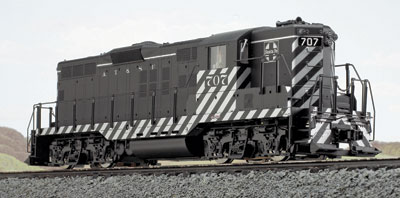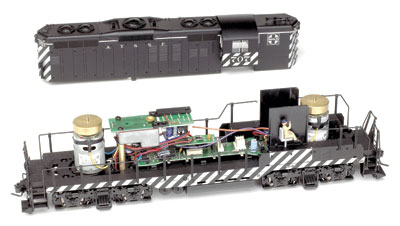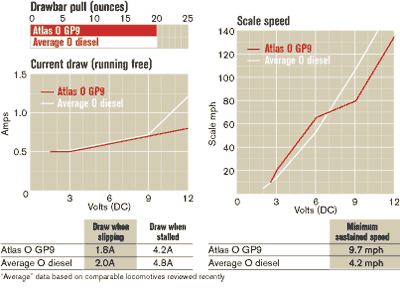General-purpose prototype. Electro-Motive Division introduced the prototype GP9 in 1954 as the 1,750-hp successor to its popular 1,500-hp GP7. This general-purpose unit continued the clean utilitarian design of its predecessor. However, GP9s can be identified by their single sets of louvers in the battery box doors just ahead of the cab and in the last side door on each side of the long hood. During their production, from January 1954 until December 1959 (Canadian production continued until August 1963), 3,436 GP9s were built for U.S. customers, while 646 were sold in Canada and 10 to Mexico.
As general-purpose locomotives, the GP9s handled all sorts of jobs from yard and local switching to fast freights and passenger service. Most rode on EMD GP-type trucks, although a few were fitted with Association of American Railroads type A switcher trucks.
The Atlas O GP9 closely matches the dimensions shown in a prototype drawing published in the Model Railroader Cyclopedia: Vol. 2, Diesel Locomotives (Kalmbach).
Our sample represents a fairly typical GP9 painted as an Atchison, Topeka & Santa Fe prototype built in 1956. In railfan terminology, it’s a phase II locomotive because of its three rows of tall louvers in the long hood and cap-top cooling fans (four 36″ radiator fans and one 48″ dynamic brake fan). It has a well-detailed plastic body with some individually applied details and wire grab irons. Separate sunshades, m.u. hoses, and air brake hoses are provided.
A heavy die-cast metal chassis, including the pilots and fuel tank, provides most of this Geep’s 4-pound, 2-ounce weight. All four sets of corner steps and the footboards have fine see-through openings, and the running boards and platforms include a nice-looking safety tread texture.
Under the hood. Internally, the chassis follows the same pattern Atlas used on its previous GP35 andP60 models. Each truck is driven by a powerful can motor mounted vertically above the kingpin. A couple of black masks within the cab hide the inner workings, while a crewman on each side of the cab adds realism.
Both motors have gimbal mountings so the trucks can move freely.The vertical motor shaft drives a worm and gear inside each truck that transmits power to a set of five spur gears that drive both axles. A smoke unit, controlled by a switch under the sill on the engineer’s (right) side of the cab, simulates diesel exhaust from both stacks.
A removable secondary printed-circuit (PC) board is provided so the model can be converted to Digital Command Control (DCC). Two plugs are provided with color-coded wires matching the NMRA Recommended Practice 9.1.1. Atlas includes separate DCC instructions covering how to connect these plugs to the main PC board and install a heavy-duty (6-amp) decoder.
The GP9 has constant-intensity, reversing lights so the headlight is illuminated only in the direction of travel. Its classification lights display a red indication to the rear to serve as marker lights for lightengine or pusher movements.
I’ve reviewed the DC model here, but Atlas also makes a two-rail version that includes the Lionel TrainMaster command control and RailSounds digital sound system, which operates only under command control.
The dual motors produce a 20-ounce drawbar pull that’s equivalent to 60 free-rolling cars on straight and level track. However, they draw more than 4 amperes.
Magnetic knuckle couplers are mounted in boxes at the proper height on each pilot.
Model Railroader’s sample GP9 is neatly and evenly painted in Santa Fe’s “Zebra-stripe” scheme with sharp edges on the stripes. The lettering was clear and opaque with colorful EMD builder’s plates on both side sills.
Overall, Atlas O has done a fine job of capturing a classic first- generation diesel locomotive with this nice-running model.
Price: Two-rail (with Lionel electronic system) $439.95
2-rail DC, $379.95
Dummy units, $199.95
Manufacturer
Atlas O, LLC
378 Florence Ave.
Hillside, NJ 07205-1102
www.atlasO.com
Description
Plastic and metal locomotive
Road names
Atchison, Topeka & Santa Fe (nos. 707, 715); Baltimore & Ohio (nos. 676, 681); Erie (nos. 1261, 1264); Milwaukee Road (nos. 2436, 2439); Southern Pacific (nos. 412, 416); and Western Maryland (nos. 30, 34)
Features
Blackened nickel-silver RP-25 wheelsets (in gauge)
Digital Command Control receptacles and wiring
Directional headlights and marker lights
Drawbar pull: 20 ounces
Eight-wheel drive and electrical pickup
Kadee-compatible scale magnetic couplers, mounted about .05″ low
Metal grab irons and handrail stanchions
Minimum radius: 36″
Separate add-on details
Twin motors with flywheels
Weight: 4 pounds, 2 ounces
Windshield wipers
















